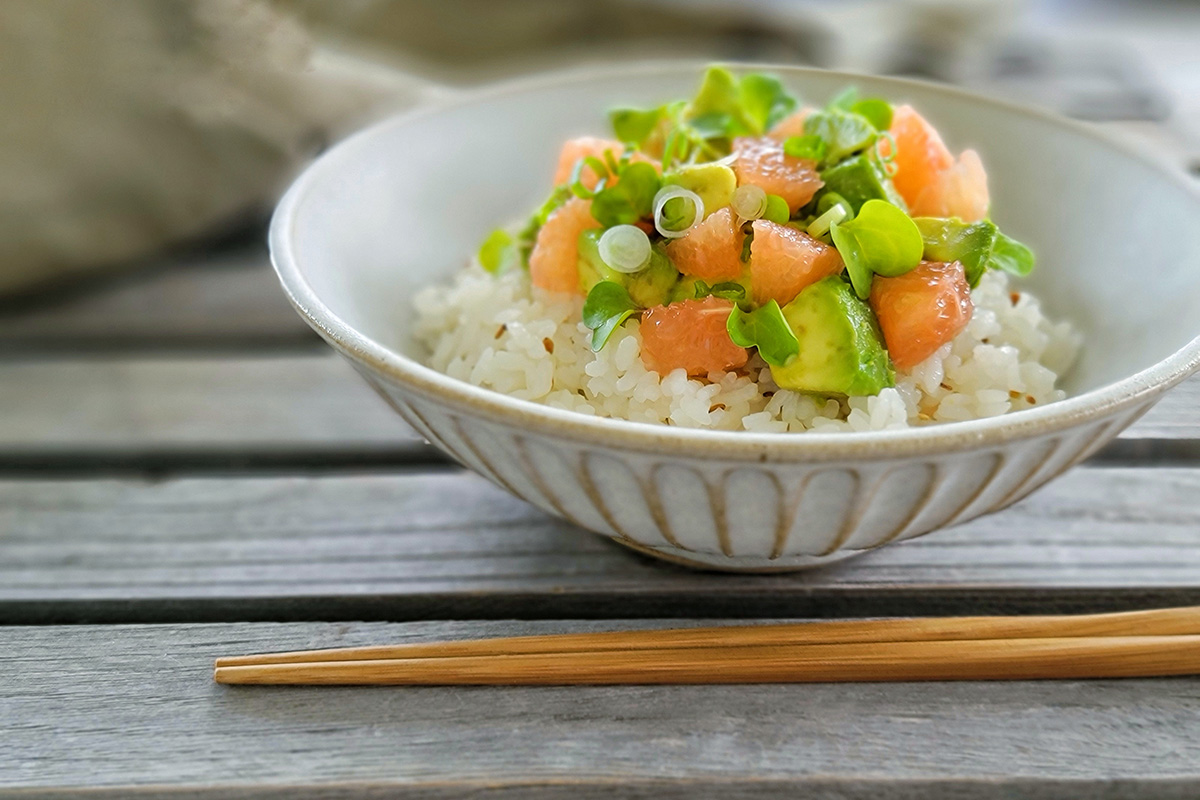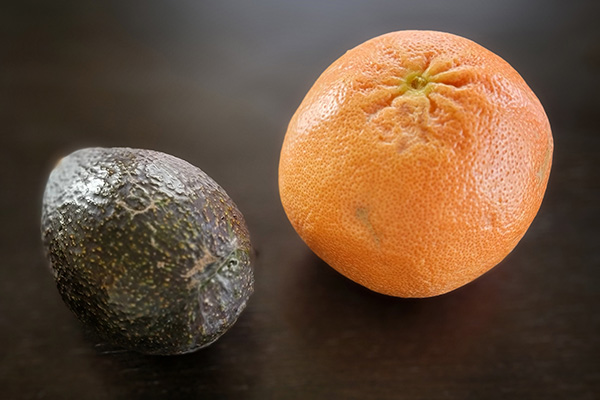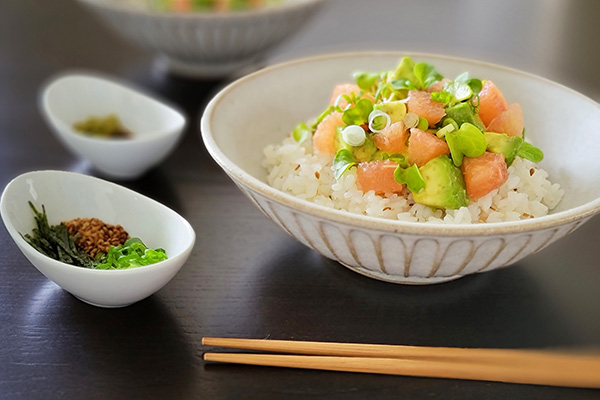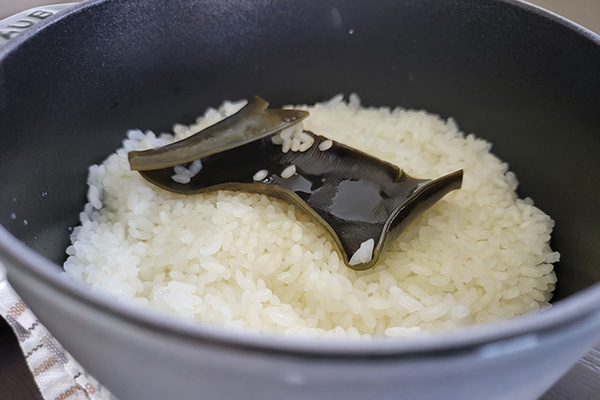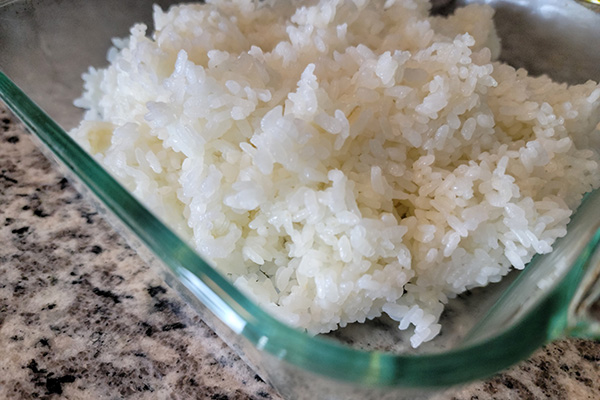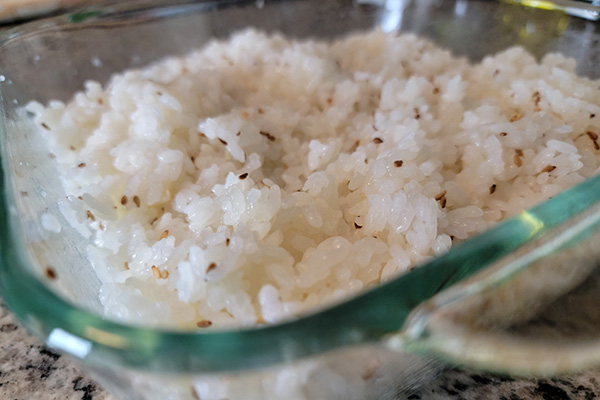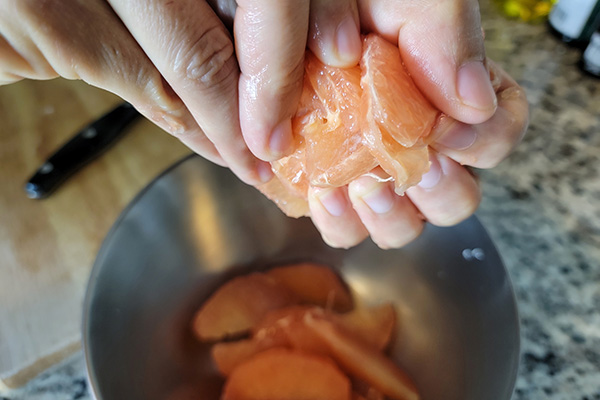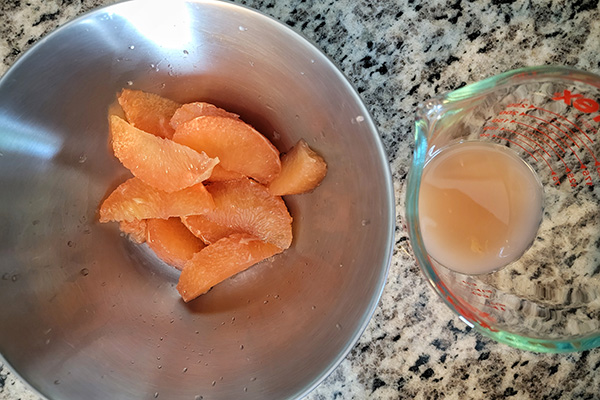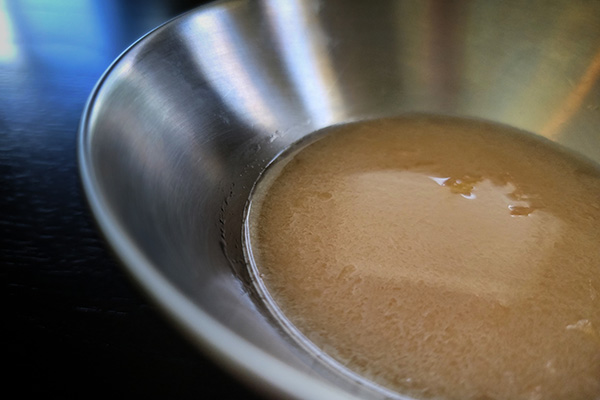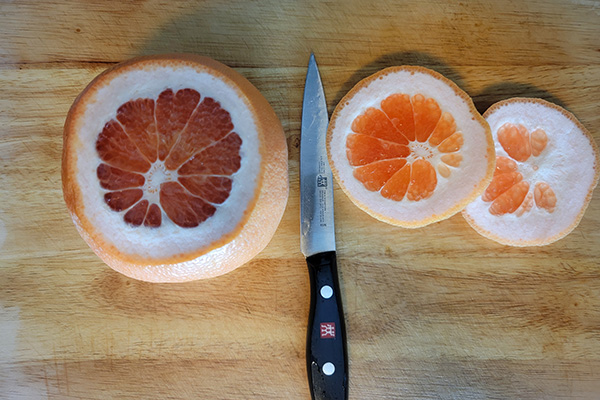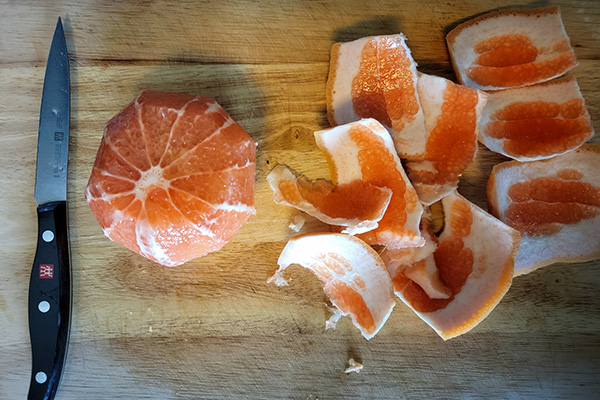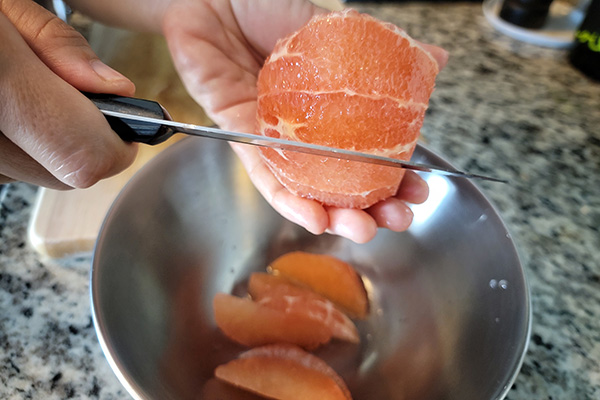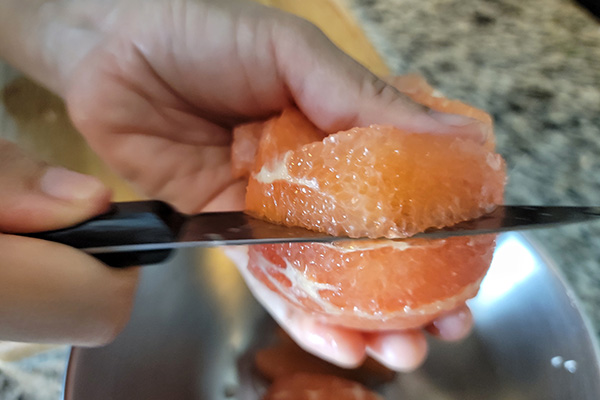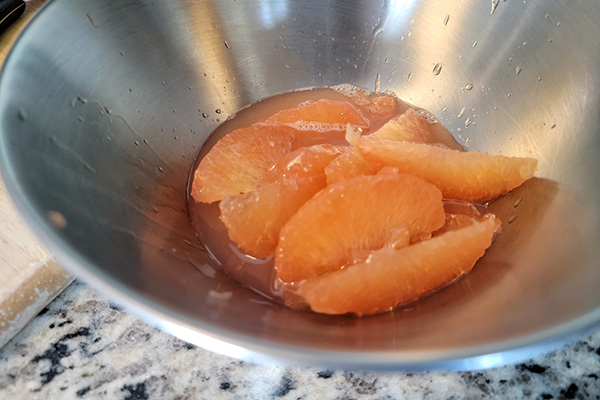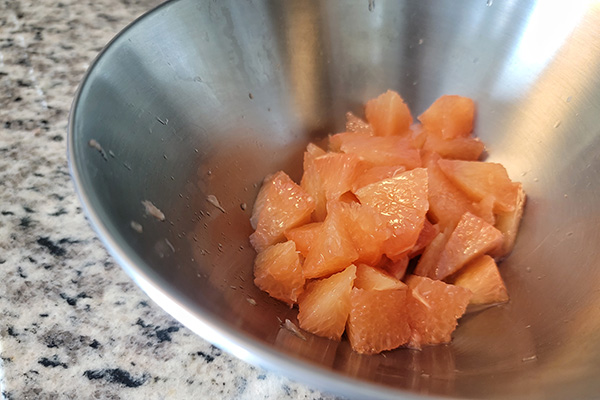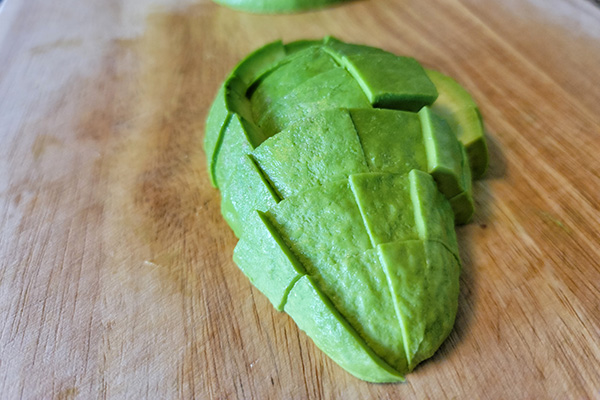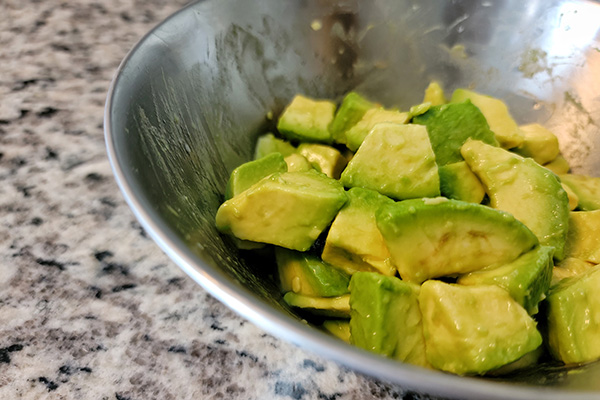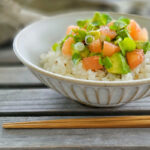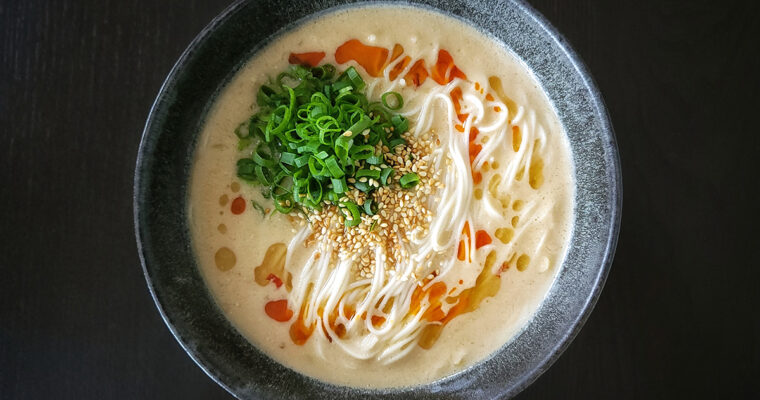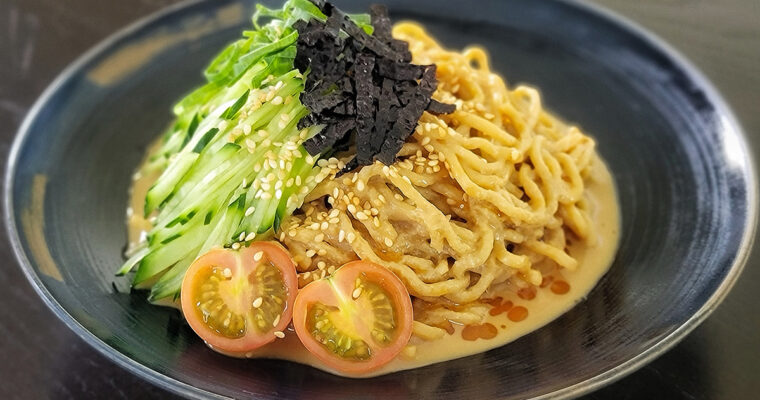Last Updated on June 2, 2022
[グレープフルーツとアボカドのちらし寿司]
I love incorporating citrus fruit in savory dishes. My Grapefruit & Avocado Chirashi Sushi is a modern take on traditional Japanese sushi. It’s savory, citrusy, slightly sweet and refreshing. I can guarantee this will be your next favorite sushi. It’s vegan, gluten-free (if using tamari and GF friendly-wasabi) with no added oil.
Grapefruit & Avocado Combo
Have you tried this particular combo? If you haven’t, you might be missing out a lot in your food journey. LOL. Believe it or not, they are also a perfect combo for making guacamole!
Growing up in Japan, fruits in savory food is something that I wasn’t used to eating. But once I discovered the potential of what fruits, citruses to be particular, can do to enhance the savory element, there’s no going back.
The easiest citrus (besides lemon) to incorporate in savory dishes would be oranges. I’ve created many recipes incorporating orange in the savory dishes such as;
Vegan Orange Infused Coconut Ramen
Fettuccine with Shiitake Orange Truffle Cream Sauce
Chickpea Salad with Fennel & Orange
The orange adds very mild acidity with sweetness without overpowering, and the aroma from the orange really stands out in the those dishes. All of those are the elements that lemon just cannot do.
And here we have this magic of citrus from the grapefruit paired with creamy avocado over sweet & savory sushi rice. I love the fact that grapefruit is less sweet than orange and slightly bitter. On contrary, avocado is very mild, rich and creamy so these two contrasted fruits work together with the savory component; in this case it’s the sushi rice and soy sauce. It may sound strange to you now but once you try it, it will automatically make sense!
What’s Chirashi?
Chirashi (or Chirashi Sushi to be more proper) is a style of sushi dish which is called Chirasizushi [ちらし寿司] in Japanese. The direct translation would be “scattered sushi” in English. I know it sounds a bit weird but actually one of the easiest style of sushi to make. In other words, no rolling and no pressing.
As the name says it all, chirashi is prepared with vinegared sushi rice topped with variety of toppings as you like. In a way, it’s kind of a bowl-like dish (ugh, I hate to say this.) Well, I’m not a bowl-kind-of-food person—I like to plate and eat each component separately.
However you want it to be, you get the concept. Ideally, it’s better to put lots of different colors & textures to make chirashizushi. In Japan, it’s often served to celebrate rite of passage so it’s a very festive yet elegant and traditional dish. But you can make it more casual at home using “contemporary” ingredients such as grapefruit & avocado. Making rolls is fun but if you crave for sushi next time but don’t feel like doing extra work, chirashi might be a lot easier option for you!
The Ingredients
Here is the list of ingredients to make this awesome chirashi-style sushi!
Rice for Sumeshi (Vinegared Sushi Rice)
- White Japanese rice (starchy short grain rice)
- Water
- Dried Kombu Sheet (optional but highly recommended)
Grapefruit Sushizu (Seasoned Rice Vinegar Mixture)
- Freshly Squeezed Grapefruit Juice
- Rice Vinegar
- Sugar
- Salt
Toppings & Condiments
- Pink (or white) Grapefruit
- Hass Avocado
- Lemon Juice (optional)
- Scallion
- Radish Microgreens or Sprouts
- Shredded Sushi Nori (optional)
- Soy Sauce (or Tamari for GF)
- Wasabi
The Tips and Recipe Notes
Here is the breakdown of ingredients & steps with some helpful tips!
Sumeshi (Vinegared Sushi Rice)
To make great sushi, using good quality Japanese white rice is essential! I’m a rice connoisseur so I talked about this in the Sumeshi post. It’s worth reading before making the rice for this recipe. In summary;
- Sumeshi is a Japanese word for “sushi rice.”
- Sushi rice actually means “vinegared sushi rice”, not generalized term for sticky rice for making sushi.
- Sumeshi is “cooked Japanese rice” mixed with sushizu (seasoned rice vinegar mixture) for making sushi.
- Sushizu is a mixture of rice vinegar, sugar and salt.
- If the rice is not seasoned with sushizu, it’s not sushi.
- Particular ratio of rice to water, the mixture of vinegar, sugar, and salt really matters.
Want to learn more? Be sure to read sumeshi post afterwards!
Note: I made it exactly the same way as the sumeshi post. The only difference is that I used a baking dish to cool down & mix the rice just to show that you don’t have to have a sushi bucket which is a proper tool for making sushi rice. Baking dish is not the best tool as the dish won’t absorb excess moisture from the cooked rice. But it’s definitely doable!
Grapefruit Sushizu (Seasoned Rice Vinegar Mixture)
What’s special about this Grapefruit & Avocado Chirashi Sushi is it’s made with sushizu mixture blended with grapefruit juice! Sushizu typically made with rice vinegar but why not incorporating the juice from the main ingredient, grapefruit? It has a good balance of sweetness and tartness which is perfect for making sushizu.
I use 1 1/2 cups uncooked rice for making sushi for 2 people (me and Peter.) It’s equivalent to 2 cups for the Asian rice measuring cup for those who have an Asian kitchen staple, rice cooker. Actually, this amount is enough for 3 people but always works for us without having unnecessary leftover rice (because we eat a lot of rice.)
To make regular sushizu mixture for the 1 1/2 cups uncooked rice, I blend;
- 3 tbsp rice vinegar
- 1 1/2 tbsp sugar
- 2 1/2 tsp salt
Bur for this recipe, I use a mix of grapefruit juice and rice vinegar for the acidity component.
- 2 tbsp freshly squeezed grapefruit juice
- 1 tbsp rice vinegar
- 1 1/2 tbsp sugar
- 2 1/2 tsp salt
I still used 1 tbsp of rice vinegar instead of entirely replacing with the grapefruit juice. Because the acidity of rice vinegar is stronger than the grapefruit juice and we need that little “punch” to season the rice otherwise it may become a bit blurred taste.
Choice of Grapefruit
In Florida where I live, I can only find pink grapefruit. Where is the white grapefruit that I grew up eating in Japan? I’ve seen once or twice being sold here but never see them again. Well, the pretty light pink color actually stands out very pretty in this dish! Not only that, the pink one is sweeter. So, I’ll recommend using pink grapefruit if you can.
Grapefruit Segments
I only cut out segments from citruses for cooking. I don’t do this for eating them as a snack. If you’ve never done this before, it’s actually quite satisfying. I enjoy the somewhat tidy process of it.
I don’t know why but it’s hard to describe the steps which I tried to do in the actual printable recipe (I tend to complicate things.) Here, I attached the photos below which should be much easier to see and comprehend.
Cut-Size of Grapefruit & Avocado
The ingredients are typically cut to a bite-size for chirasi-style sushi. For grapefruit, after cutting out the segments, all you have to do is to cut each segment into 4 pieces.
For avocado, you can peel and dice on a cutting board like I did or dice in a peel (by scoring) then scrape it out with a spoon. I wanted to get somewhat of an clean-cut looking diced avocado so I did the first option. We all eat with eyes first so details matter!
What I also did was to dress the diced avocado with remaining grapefruit juice. It not only adds the flavor but also keep the bright color longer. If you have no more juice left after making the sushizu, squeeze a little bit lemon juice (or even rice vinegar) on it.
Radish Microgreens or Sprouts
When I make Japanese flavor dishes, I like having a touch of radish taste without eating the actual flesh of it. The Japanese people actually do this often by adding grated daikon radish or daikon radish sprouts to give a hint of freshness & punch to the dish. Adding radish microgreens or sprouts are easy and a perfect way to have a little taste of it!
Shredded Sushi Nori
Since it’s sushi, I like adding nori to the dish. but you can’t just put a nori-sheet on it. One way to add nori to the dish is using a product called kizaminori. It’s a popular Japanese pantry item which is simply shredded nori. So, all you have do is to sprinkle a pinch over the dish.
Or if you don’t have one, you can easily make the same thing by using regular sushi nori sheet. You can either tear nori sheet with hands or shred thinly using kitchen scissors which I do the latter. The end result is kizaminori.
Soy Sauce & Wasabi
I use regular soy sauce for everything but tamari is actually a good choice not only for GF but for the taste as well. In Japan, tamari is often used for sashimi (not vegan) but it pairs very well with sushi. It’s slightly thicker and sweeter than the regular soy sauce.
You know how well the combo of soy sauce & wasabi works for avocado, but trust me! It’s great with grapefruit, too! By the way, if you’re on gluten-free diet, be sure to check the label of you wasabi which may contain wheat as an additive.
Feeling Inspired?
Check out other popular vegan sushi recipes!
King Oyster Mushroom “Fish” Nigiri Sushi
Grapefruit & Avocado Chirashi Sushi
Ingredients
Rice for Sumeshi (Vinegared Sushi Rice) *
- 1 1/2 cups uncooked Japanese white rice (starchy short grain rice)
- 1 1/2 cups water
- 0.3 oz dried kombu sheet
Grapefruit Sushizu (Seasoned Rice Vinegar Mixture) *
- 2 tbsp freshly squeezed grapefruit juice
- 1 tbsp rice vinegar
- 1 1/2 tbsp sugar
- 2 1/2 tsp salt
Toppings & Condiments
- 1 large pink grapefruit (or white one) (12-15 oz)
- 1 large Hass avocado
- Lemon juice (optional)
- 1 scallion thinly sliced
- Radish microgreens or sprouts
- Shredded sushi nori (optional)
- Soy sauce (or tamari for GF)
- Wasabi (check label for GF)
Instructions
- Prepare rice for the sumeshi. Place rice in a large bowl. Pour water to cover the rice. Wash it with your hand moving in circular motion then quickly discard the water. Repeat the process 5 to 6 times until water becomes clear. Drain well. Alternative way: Place rice in a fine mesh colander. Rinse under running water. Use a hand moving in circular motion to rinse thoroughly until water becomes clear. Drain well.
- Transfer the rice to preferably a cast iron pot with a heavy lid or something similar. Pour water and make the rice leveled. Place kombu sheet on top of the rice (submerge in the water) and cover with the lid.
- Cook over slightly higher than medium heat. In about 10-15 minutes, it starts almost boiling (you will see the bubbles.) At this point, open the lid and use a rice paddle to give a quick stir from the bottom. Make the rice leveled again then cover with the lid. Reduce the heat to low and continue to simmer for 10 minutes. After the 10 minutes, turn off the heat. Keep the lid on and let it stand for 10 minutes.
- While rice is still cooking, start preparing the toppings & condiments. For grapefruit, slice off the top and bottom end. Then place it cut-side down and carefully slice off the entire peel & membrane.
- Once the entire flesh is exposed, cut out the segments one by one. Do this over a bowl to catch the segments as well as the juice. After all the segments are cut out, squeeze the remaining to get the juice out. Important: the juice will be used to make the sushi vinegar later
- Grab the segments from the bowl and cut them into smaller pieces (about 1/2-inch or 1.3 mm.) Then put them back in the bowl. Set aside.
- Make the grapefruit sushizu (seasoned rice vinegar mixture.) Transfer 2 tbsp freshly squeezed grapefruit juice (from step 5) into another bowl. To that, add rice vinegar, sugar, and salt. Whisk together until well blended. Set aside. You may see the sugar and salt not quite dissolved which should be fine once it is mixed with warm rice.
- When the rice is done, remove the kombu sheet and transfer the cooked rice to a large shallow bowl (preferably wooden sushi bucket for soaking up excess moisture.) Add the grapefruit sushizu and mix with a rice paddle. To do so, move in gentle cutting motion. Once it is mixed well, use a fan to let the rice cool down until ever so slightly warm like your body temperature. Sushi rice tastes better when it is not completely cold. Lastly, add toasted sesame seeds and mix again. Set aside.
- At this point, start dicing avocado roughly the same size as the grapefruit segments. Place the diced avocado in a bowl and pour the remaining grapefruit juice. No juice left? No worries. You can also use a tiny splash of lemon to keep the avocado from turning brown (optional.)
- To serve, place the rice in a serving bowl or plate. Top with the grapefruit, avocado, scallions, radish microgreens or sprouts and shredded nori (optional.) Pour soy sauce along with wasabi over and enjoy!
Notes
- My Sumeshi (vinegared sushi rice) recipe makes 2-3 servings by default. For leftover rice (if any), you can store in a fridge and make fried rice the next day! It’s already seasoned but it works fine.
- For this recipe, I make sushizu (seasoned rice vinegar mixture) mix with grapefruit juice to mix with the other traditional sushizu ingredients; rice vinegar, sugar and salt. If your grapefruit doesn’t give you enough juice (2 tbsp) just fill the rest with extra rice vinegar.
